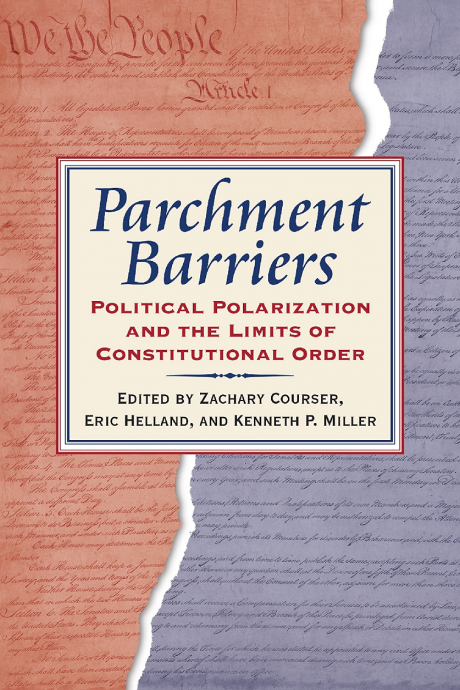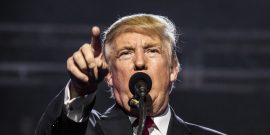Jonathan Gienapp's new book falsely sees the Framers' criticisms of parchment barriers as evidence that the Constitution did not have a fixed meaning.
What Are the Real Fault Lines Dividing Americans?
The idea that America is “polarized” is now so accepted and entrenched that few feel it necessary to justify the claim. Our political divisions are important, and the plethora of scholarship they have rightly attracted varies in quality. Parchment Barriers: Political Polarization and the Limits of Constitutional Order, edited by Zachary Courser, Eric Helland, and Kenneth P. Miller, is the latest addition to the genre, and one of the stronger books on the subject. However, the book’s importance hinges on whether ideological polarization really exists in the United States.
Although political polarization is not a uniquely American phenomenon, it does seem to manifest differently in the United States than in other advanced democracies. Parchment Barriers suggests that America’s constitutional design, and the nation’s unique political institutions, in some ways ameliorate polarization but in other ways increase it.
The volume’s contributors examine these subjects by institution. George Thomas begins the work with an essay on James Madison’s vision of the Constitution, discussing the original intent of checks and balances, and how they should be utilized to achieve effective government. Others take up polarization in relation to Congress, the presidency, the judiciary, the administrative state, American federalism, and political parties. The book ends with Joseph M. Bessette’s qualified defense of polarization.
Every chapter provides valuable information and insights, but I particularly recommend Benjamin Kleinerman’s essay on the presidency. Kleinerman notes that we increasingly view the President as something akin to the head of a parliamentary democracy, with a mandate to pursue legislation. The administrative state’s growth furthermore gives the President authority to make important policies without congressional approval. As a result, the presidency is not just the ultimate prize in politics, but the sole obsession of political parties. According to Kleinerman, “The logic of partisanship in relation to a prize like the presidency requires commitment without compromise.” The parties’ zeal to gain and hold the White House makes bipartisan cooperation increasingly unlikely.
As the editors note in the Introduction, the book’s contributors “agree that polarization is now a defining feature of the nation’s politics and is placing strains on our institutions and political life.” The authors discuss polarization in Madisonian terms. Madison wrote of factions forming around opposing economic preferences; agrarian interests opposed to manufacturing interests, for example. It is taken for granted in this book that opposing interests drive polarization, and that factions form around different material concerns.
This Madisonian variety of polarization exists, of course, but political polarization in the United States in the 21st century is also much more complex—and, in some ways, bizarre—than Madison or his contemporaries could have ever anticipated.
The Differences Between the Two Parties Are More Ostensible Than Real
It is a stretch to say that the American electorate is ideologically polarized. There is far more consensus in American life than we often acknowledge. For better or for worse, most Americans endorse an economic system of welfare capitalism, leaving either socialism on the one hand or libertarianism on the other as political non-starters. Few of even the self-proclaimed socialists literally want the government to seize the means of production; most just want a larger welfare state. By the same token, few supposed economic conservatives genuinely want to abolish, or even seriously reform, Medicare or Social Security.
Several of the Parchment Barriers essayists argue that the public is increasingly polarized along ideological lines. Yet there is compelling evidence that few Americans possess a coherent ideology. The authors herein who acknowledge this lack do not explore it in any detail.
There is no doubt that huge number of Americans are angry about politics. However, attitudinal polarization is not the same thing as ideological polarization. We are faced with a curious situation where Republicans and Democrats in the electorate broadly agree on many issues, yet they hate each other anyway. Partisan politics has become a form of identity politics, and all battles—even symbolic or superficial battles—induce powerful emotions on the part of party identifiers.
One can reasonably make the case that, even if the rank-and-file members of the electorate are not polarized, polarization is present among political elites. Yet even this argument should not go unchallenged.
At the presidential level, we see a lot more continuity across administrations than we would anticipate, given the polarized attitudes toward recent Presidents—again, for better or worse. For all the conservative handwringing, the policy differences between President Obama and his immediate predecessor were primarily at the margins. Obama’s foreign policy vision was substantively like that of the neoconservatives. His signature domestic policy achievement, the Affordable Care Act, was inspired by work originated by the Heritage Foundation (a conservative think tank), and a similar policy had previously been enacted at the state level after being signed into law by a Republican Governor (Mitt Romney) of a predominantly Democratic state (Massachusetts). The ACA might have been bad policy, but it was no more left-wing than the decision by President George W. Bush and a Republican Congress to add prescription-drug coverage to Medicare.
President Trump has likewise been less disruptive than many people feared (or hoped). If you disregard the President’s Twitter feed and his verbal jousting with the media, the Trump administration’s actual policies have been mostly consistent with what one would expect from any Republican President.
The claim that Congress is more polarized than ever is typically based on trends in party-unity scores. Kathryn Pearson’s chapter on Congress in this book relies heavily on data concerning party unity. The data, while accurate, might not be as substantively important as many claim. DW-NOMINATE data are based solely on congressional voting patterns, and while they do show that both parties are increasingly cohesive, they tell us nothing about the actual significance of the bills being voted on. Greater party discipline does not prove that the parties have become more ideologically distant from one another.
Congressional Sound and Fury
We might also question the degree to which ideological grandstanding on the part of members of Congress signifies a true intention to implement major policies. As we learned following President Trump’s unexpected victory in 2016, congressional Republicans never had an actual healthcare plan of their own.
We take it for granted that the GOP would, if it enjoyed massive majorities in Congress and control of the presidency, implement the economic policies of a conservative purist. I am not sure this is true. Public opinion polls consistently show that doctrinaire economic conservatism is not popular, and the Republican leadership surely knows this. Other than the perennial call for tax cuts, the GOP has not made a serious push for a major economic policy innovation since 2005, when President Bush’s attempt to partially privatize Social Security was a political disaster.
Congressional Republicans like to lambaste their Democratic opponents for blocking their agenda (and vice versa), but if either party were given a free hand, I question how radical either would be when it came to most policy questions. In other words, checks and balances, and their associated gridlock, give parties a convenient excuse when the few genuine ideologues in their respective bases complain that elected officials have not pushed a more ambitious agenda.
The anger in American life, though perhaps overblown by the media, surely exists. Yet America’s livid multitudes do not resemble rational, Madisonian factions. Partisan politics are founded upon tribal loyalties as well as material interests, and our most bitter political disagreements are often more symbolic than substantive.
In defending polarization, Bessette points out that Abraham Lincoln chose to polarize the nation on slavery rather than allow the possibility of a long-term compromise, and he lauds Lincoln for doing so. Bessette suggests that we today may face a similar choice between compromise and polarization, and that sometimes polarization is the moral choice. Yet this seems to exaggerate the stakes of today’s policy battles.
What Is the Discord Really About?
Although the fury many American feel about politics is real, and perhaps more palpable than any time since before the Civil War, is it really rooted in policy disputes on a par with the question of slavery? This is obviously a subjective question, but the matters that generate so much heat in American politics—rules about bathroom usage for the transgendered, for example—seem, to me at least, comparatively trivial.
As noted in this volume, long before polarization was the primary complaint about American politics, E.E. Schattschneider and other political scientists lamented the lack of clear dividing lines in American politics. What we call polarized parties, Schattschneider called “responsible parties.” The Parchment Barriers essayists suggest that Schattschneider’s goal has been attained, perhaps too well. I remain unconvinced. Do millions of American partisans genuinely despise the people in the opposing political camp? Unquestionably. Are Republicans and Democrats ideologically distant political forces, demanding radically different policy visions? I think the answer to that question is less obvious.
We are polarized, but not in the manner that earlier political theorists could have foreseen. For all his wisdom, I am not sure Madison can give us much guidance as we navigate 21st century American politics. Parchment Barriers has many virtues, and its contributors have many important insights, but it neglects some of the more curious and challenging aspects of American polarization, which limits its usefulness as a guide for possible reforms.


